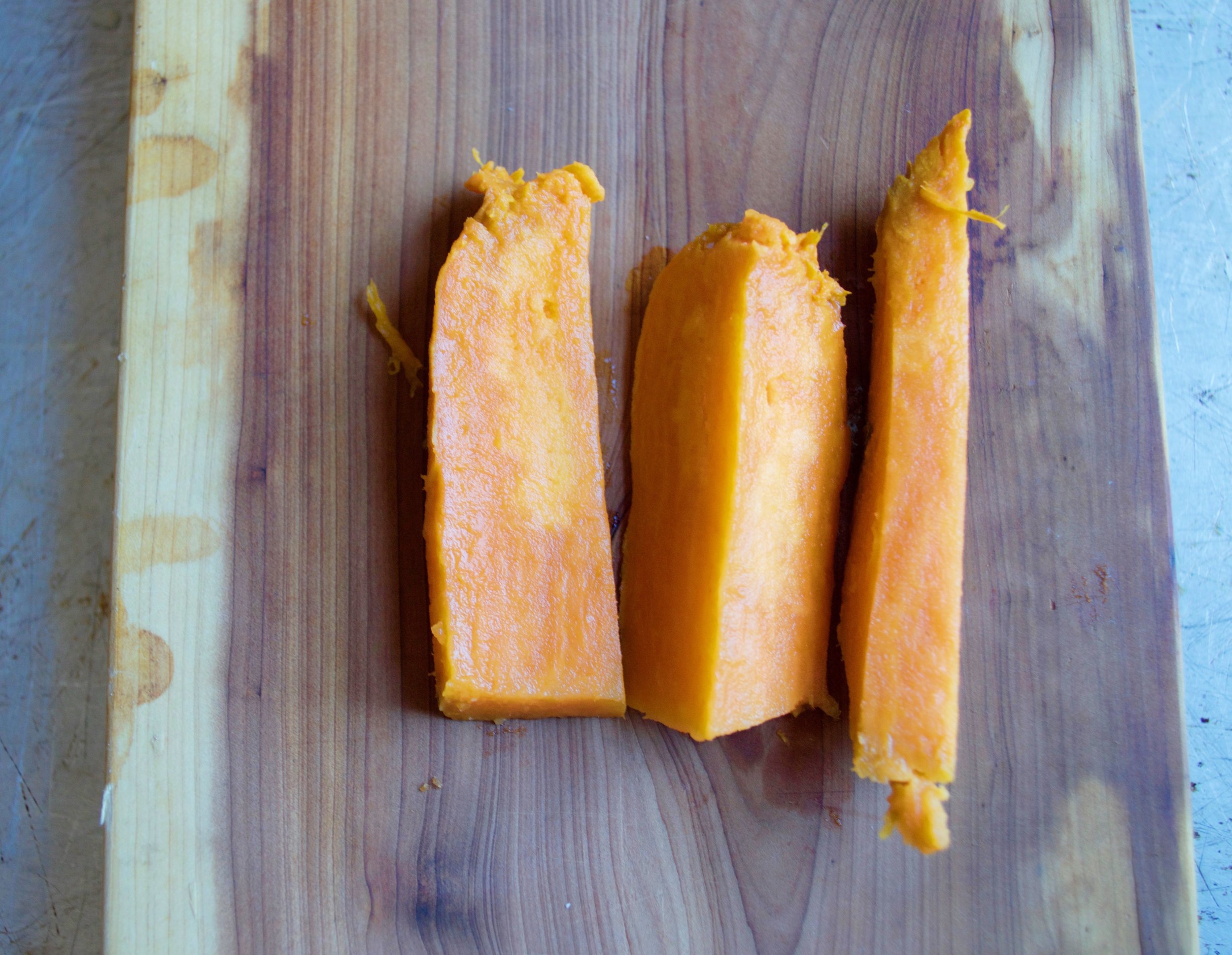Raising Adventurous Eaters: A Laid-Back Guide to Baby-led Feeding (and 14 Favorite First Foods!)
In the last post, we breezed through Ruthie's eating experiences with baby-led feeding. Now she's two and eats pretty much everything, including the occasional lightning bug.
Back to the food newbies (around* 6 months), how much food are we supposed to be giving these guys? And when? I'll answer both of those questions here along with a list of my favorite first foods.
*There is not a specific age at which to begin solids though the American Academy of Pediatrics recommends exclusive breastfeeding through 6 months. Think about beginning solids or complementary foods (any food other than breast milk or formula) when your baby shows signs of readiness, not based on their age or weight. Here is some guidance on signs of readiness from a pediatric dietitian.
My Approach
I use a modified baby-led feeding approach meaning I mash some foods and offer them preloaded on a spoon along with offering finger-shaped slices. The goal is to still encourage self feeding - babe grasps the food and moves it to her mouth or holds the spoon herself. If you the parent are in control of the spoon, encourage self feeding skills by remaining neutral and allowing babe to lean into the spoon herself. Offer over control of the spoon occasionally until babe feels ready to step in (usually doesn’t take long!).
Baby-led feeding has taken on a new definition for me since working with so many families on the process. It is more about the feeding dynamics between parent and babe than it is the type of food offered. In my practice, baby-led feeding is simply that: letting baby take the lead on feeding. That can mean feeding themselves, or it can mean a very receptive parent assisting babe in eating while paying close attention to his cues and encouraging his ability to self feed.
Introduction of solids is more of a parenting decision than a medical one. You are completely in charge of how & when to introduce foods.
The main goals are:
1. get both parent and babe familiar with food other than breast milk or formula
2. nurture and encourage babe’s intuitive responses to eating (let them eat when their hungry, as much as they are hungry for, stop when they are full)
3. pick up certain nutrients that are needed around this stage of baby’s life
Soft roasted sweet potato.
Ripe avocado.
Soft roasted cauliflower with coconut oil and tumeric.
Butternut Squash - roasted with olive oil and cinnamon.
Food Shape + Texture
These photos show some example portion and slice sizes. While offering food in this shape makes it easier to grasp, offering soft mashed food is fine as well (the palmar grasp is actually a pretty effective way for new eaters to get food into their mouths). Even pureed foods offered on a spoon can be part of baby-led feeding if baby is the one leading the feeding (see above for a little more on that).
Amount
I put 1 of the slices in the picture out at first feeding so babe can begin to associate the amount of food they're eating with fullness (verrrrry beginnings of mindful eating). I will definitely offer more if they seem interested. You might also put out the entire portion out at the beginning, whatever works for you and your babe.
New food waiting period
There is no need to follow a waiting period between offering new foods. In the beginning days of feeding my own, I was so used to exclusively breastfeeding that there were days I skipped solids completely simply because I forgot. No need to write out a schedule and stick to it (unless you like that sort of thing, you weirdo. Kidding, I want to be like you).
When to offer
Offer food to baby when you yourself are sitting down to eat. Babies learn a lot about eating by watching us (and by watching older siblings!). Try not to pressure/force/cajole/persuade babe to eat, it is totally fine if no food is consumed at a meal or snack. Just offer them regularly and when babe is ready, she will eat. For about the first year, babes are still meeting most of their nutrient needs from breast milk or formula.
Scheduling breast milk/formula feeds
Scheduling solid food in between feedings can be tricky if you're like me and nurse on demand. Rather than worry about scheduling solids around breastfeeding (or rushing to squeeze in a nursing session right before or after a feeding of solids) I simply offer solid food at the times my toddler and I are sitting down for meals or snacks and breastfeed on demand the rest of the day. Some meals/snacks babies may eat a lot, and sometimes they may eat nothing at all. Allow them to remain in control of their intake.
First foods
Honestly, the first food you offer doesn’t really matter all that much. BLW purists suggest simply feeding whatever the family is having for a meal to baby, which is totally fine as long as the texture is appropriate. Working with families through this milestone has taught me that moms are pretty amazing and often want to do something a little special for baby’s first food and truly and enjoy hearing suggestions on what to offer first. See list below for a few ideas.
There is a myth you're probably familiar with that starting fruits before vegetables will encourage your babe to enjoy only sweet flavors. They already love sweet tastes because they're human and sweet stuff tastes great (also because bmilk and formula are both sweet tasting). Start with whatever food works for you.
Iron
The one technicality (in an otherwise laid-back approach to feeding) is Iron. As the time this post was published, current research suggests breastfed babies require exogenous iron beginning around the middle of their first year. This means regularly including easily absorbed iron rich foods in their diets beginning around 6 months. Read this post for a more in depth look into Iron and BLW. If you are vegan or plant based, I suggest following Plant Based Juniors for guidance on ensuring babe is getting enough iron and zinc.
15 Favorite First Foods:
Any of these foods can be cut into adult finger shaped sticks for self-feeding, or mashed and offered with a spoon. No need to thin with added liquid and/or puree (unless you would prefer to!). When roasting or sauteing, I usually use olive or coconut oil.
1. Banana (ripe and soft) - offering with the skin on is great! Although my babe’s very quickly found the skin to be a hindrance once they became more efficient eaters.
2. Sweet potato (roasted or baked, skin removed)
3. Slow cooker chicken, shredded - excellent source of easily absorbed iron, offer with vitamin C rich fruit or veggies for even better iron absorption.
4. Honeydew or cantaloupe (ripe and soft)
5. Lentils (cooked until well done) - awesome iron source
6. Avocado (ripe and soft) - try rolling in ground flaxseed or baby cereal for easier grasping
7. Butternut squash (roasted and scooped out of skin)
8. Pumpkin (roasted or canned works too, how easy is that!)
9. Plain whole milk yogurt
10. Cauliflower (roasted or steamed until soft)
11. Broccoli (roasted or steamed until soft)
12. Zucchini (sauteed or roasted until soft)
13. Acorn squash (roasted and scooped out of skin)
14. Black beans (cooked until well done or canned without salt, mashed)
Learning about introducing foods to your baby can be frustrating because there is so much conflicting information that can leave you feeling less confident than when you started researching. While the articles I write are my person and professional experiences, they're also backed by a combination of current research, AAP guidelines, and extensive education on nutrition and its role in health.
This is babe's first experience with food, how exciting is that? I wish I could go back and taste food for the first time. I hope it's a relaxed and non stressful time for you. If you ever read anything confusing, send me a message and I'd be so happy to help.
My new BLW book is available on amazon now! If you’re interested, you can check it out at the link below. (This is an affiliate link, which means a small chunk of each sale goes directly to me and my fam! <3)
The information in this article is general in nature and intended to share my personal experiences, it is not medical advice. Please discuss any medical concerns with your physician.









